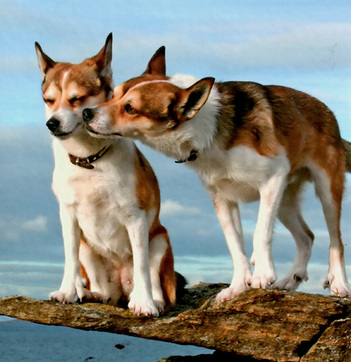Norwegian Lundehund Genomics - How Genes Influence the Gut Microbiome in Health and DiseaseBreed Coordinator: Ingvild Espelien (Breeding Committee of the Norwegian Lundeund Club, Norway)
Scientific Team:
|
Support this project (501(c)3 pending)
|
GOALS

The Norwegian Lundehund is unique and of high cultural significance in Norway, but the breed is in danger of collapse due to a severe bottlenecked population (only 5 dogs as recently as the 1960s).
We will use high-density genomic information on 170,000 SNP’s and information about DLA and mtDNA which will be genotyped in a high proportion of individuals to:
Lundehunds suffer from a high incidence of bowel disorders, the “Lundehund syndrome”, which is often fatal. In order to help save this unique breed as well as provide fundamental insight into similar human gut disease, we propose to carry out a combined survey of the breed’s neutral and non-neutral DNA as well as the associated microbes in healthy and sick dogs. Research into the human microbiome has recently revealed important contributions of gut microbes to our health as well as disease. One of the key limitations on this field is that the relationship between our genes and which specific microbes associate with us is unclear. Solving this problem requires having a detailed genetic map of many individuals as well as the microbial composition of their guts, i.e. a “metagenome-wide association study”. Such datasets are difficult to obtain and prohibitively expensive in humans due to high human genetic diversity and the relatively low occurrence (~1%) of specific gut disorders. The Lundehund is different. Because of its extremely low genetic diversity and high prevalence of a characteristic gut disorder (~40%), far fewer individuals can be studied to yield the same type of metagenome-wide association information.
We will use high-density genomic information on 170,000 SNP’s and information about DLA and mtDNA which will be genotyped in a high proportion of individuals to:
- Increase our understanding of how genetic variation in specific regions of the genome is affected by small population size and inbreeding.
- Compare the loss of heterozygosity expected from the genealogic history with that observed by molecular methods.
- Find out if nuclear and mtDNA diversity were higher in the past and in which other dog breeds the same mtDNA type(s) can be found.
- Identify favorable characteristics of candidate breeds suitable for inter-crossing and outbreeding to increase the genetic diversity without introducing deleterious genetic variability.
- Genetic markers that associate with disease in the dogs.
- Microbial species that associate with one-another.
- Microbial species that associate with genetic markers (both nuclear DNA and DLA).
Lundehunds suffer from a high incidence of bowel disorders, the “Lundehund syndrome”, which is often fatal. In order to help save this unique breed as well as provide fundamental insight into similar human gut disease, we propose to carry out a combined survey of the breed’s neutral and non-neutral DNA as well as the associated microbes in healthy and sick dogs. Research into the human microbiome has recently revealed important contributions of gut microbes to our health as well as disease. One of the key limitations on this field is that the relationship between our genes and which specific microbes associate with us is unclear. Solving this problem requires having a detailed genetic map of many individuals as well as the microbial composition of their guts, i.e. a “metagenome-wide association study”. Such datasets are difficult to obtain and prohibitively expensive in humans due to high human genetic diversity and the relatively low occurrence (~1%) of specific gut disorders. The Lundehund is different. Because of its extremely low genetic diversity and high prevalence of a characteristic gut disorder (~40%), far fewer individuals can be studied to yield the same type of metagenome-wide association information.

